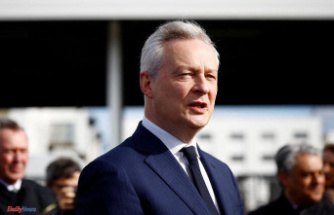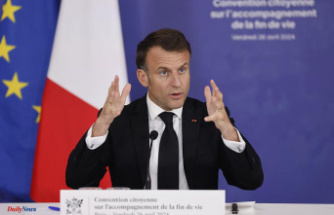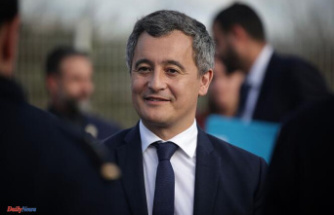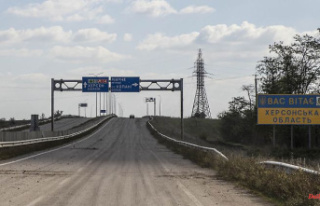The transfer of thousands of soldiers to Belarus raises the question of whether Russia wants to march on Kyiv again from the north. According to various sources, a covert mobilization is already underway in the neighboring country.
How badly Putin had miscalculated his attack on Ukraine became apparent at the latest when the Russian troops abandoned their attack on Kyiv barely six weeks after the start of the war and retreated to where they had started it: to Belarus. Although the war has been raging on in eastern and southern Ukraine since then, there are now increasing signs that Moscow could also reopen the "Northern Front" - involving the Belarusian army.
Since the beginning of the war, Minsk ruler Alexander Lukashenko has been doing his utmost to rhetorically cheer on Russia's offensive and condemn the "collective West" as a threatening common enemy. At the same time, he downplays his country's role, even though his regime is providing significant support for the attack. Because while before 2020 Belarus still used its "security policy neutrality" as an important trump card in the seesaw policy between East and West, Lukashenko has been completely dependent on Putin's support to stay in power since the peaceful protests were crushed.
And so in the course of 2021 Moscow had already gained a stronger military foothold in Belarus - through constant maneuvers, the stationing of missiles, patrol flights by nuclear-capable bombers and the establishment of "army training centers". Shortly after the war began, Minsk cleared the way for the deployment of Russian nuclear weapons through a dubious referendum. For their attack on Ukraine, Putin's troops made extensive use of Belarusian infrastructure - rails, roads, airfields, barracks, hospitals - and the latent threat remained that Belarusian troops could also join the invasion. However, despite numerous rumours, this did not happen and there was often speculation as to whether Lukashenko actively opposed Putin or whether he simply had not given such a "request" enough emphasis.
After the "regrouping" of the Russian attack to the south-east, Belarus slipped back from view for many. There were significantly fewer rocket attacks from there and a bit of normality returned in Kyiv, near the border. But since the partial mobilization in Russia, the Ukrainian counter-offensive and the explosion on the Crimean bridge, the picture has changed. Putin urgently needs fighters and weapons to turn the tide in his favor, or at least to back up the land grabs that have taken place so far. A "reopening" of the northern front with Belarusian participation seems an obvious option, and various factors indicate that this is being actively prepared.
First of all, Lukashenko sharpened his rhetoric again after the recent meetings with Putin. His country has long been part of the "special operation" and supports Russia in "every possible way". Belarus is not planning an attack, but will defend the fatherland in the event of a "provocation by Ukraine". The fact that such a move is imminent is being spread on all channels - even the Ukrainian ambassador was summoned to attract attention from the media. Similarly, the Belarusian KGB chief Ivan Tertel has recently been swearing by war rhetoric among the workforce of state-owned companies. And it doesn't stop with words.
According to various sources, a covert mobilization is already underway in Belarus. Military units are placed on "high combat readiness", personnel and equipment are increased to war-level levels, and constant exercises and drills are held. After the "inspections" were announced, recruits were examined extensively, especially in the regions, and members of the military were forbidden to leave the country. In addition, on October 10, the regime announced nationwide "anti-terrorist measures" that are adding to the already high level of repression and fueling the climate of fear. At the beginning of the war there were spontaneous protests in Belarus and subsequent acts of sabotage against the railway network. Most recently, the democratic forces in exile announced that they had drawn up a plan to overthrow the regime on "Day X" with the help of up to 200,000 already registered opponents of Lukashenko, including members of the security forces.
Both Lukashenko and Putin know that polls show that while around half of Belarusians follow the Russian propaganda narrative, almost 90 percent oppose the active participation of the Belarusian army in the war. Despite all these repressions, an all too obvious entry into the war with many fatalities could spark a new dynamic of protest, which both want to prevent. There are also doubts about the fighting morale of the already little more than 15,000 regular combative Belarusian soldiers - not to mention the freshly drafted recruits. It is therefore still unclear what scenario the increased activities in Belarus will lead to.
At a recent summit in Kazakhstan, Putin railed that the Ukrainian "authorities" had lost the "will to negotiate" after his troops withdrew from the Kyiv area. So he could aim to force President Volodymyr Zelenskyj to make territorial concessions by launching a new attack on the capital and end the war "face-saving". But that doesn't seem very promising. Nevertheless, at the beginning of October, Minsk and Moscow announced the formation of a joint regional combat group, which would comprise the impressive number of 70,000 soldiers and would be under a joint command. Under Russian control, the Belarusian soldiers could remain in Belarus during a new offensive and take care of supplies, maintenance and logistics - areas that the Russians sorely lacked in March. But even though thousands of Russian soldiers including modern combat equipment were recently relocated to Belarus, this target is still a long way off. At best, it could probably be achieved next spring, and such an advance would not remain hidden. Observers such as the British secret service are therefore speaking of a major diversionary maneuver at the moment.
It is unclear whether Minsk and Moscow actually expect that Kyiv, under the impression of a possibly imminent new attack on Kyiv, would not wait and instead fire on barracks and ammunition depots in Belarus - and thus give the propaganda there an excuse to "defend" itself have to. But Kyiv has never officially taken responsibility for counterattacks on Russian territory. Since Russia and Belarus are united in the "Union State" and the CSTO military alliance as a defense community, such a step by Ukraine would be unlikely. However, should the Russian-Belarusian propaganda need a "provocation," it could also be produced as a "false flag" operation if necessary.
Then a "reopening" of the northern front could take the form of widespread "pinpricks" instead of a major advance. The Ukraine-Belarusian border is a good 1,000 km long and limited advances by ground forces or pure artillery strikes would have the potential to tie up significant Ukrainian troops in the north, which would be missing for the counter-offensive in the east and south. Apart from that, however, the effect would be a long attrition with high destruction and limited military use. But Russia has already had practice in this, too.
In any case, recent events have shown once again how important Belarus' slide into totalitarianism and the country's submission to Putin's war plans were and will remain, and that long-term peace in the region can only be secured if Belarus becomes more independent again , free state returns to the circle of peaceful countries.
Jakob Wöllenstein heads the international office of the Konrad-Adenauer-Foundation Belarus based in Vilnius.












